Russian Navy
The Russian Navy (Russian: Военно-морской флот (ВМФ), romanized: Voyenno-Мorskoi Flot (VMF), lit. 'Military Maritime Fleet', VMF) is the naval arm of the Russian Armed Forces. It has existed in various forms since 1696, the present iteration of which was formed in January 1992 when it succeeded the Navy of the Commonwealth of Independent States (which had itself succeeded the Soviet Navy following the dissolution of the Soviet Union in late December 1991).
| Russian Navy | |
|---|---|
| Военно-морской флот Российской Федерации Voyenno-morskoy flot Rossiyskoy Federatsii | |
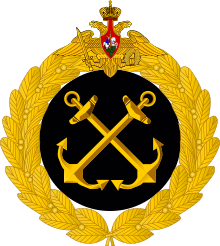 Emblem of the Russian Navy | |
| Active | 1696–1917, 1992–present |
| Country | |
| Type | Navy |
| Role | Naval warfare |
| Size | 148,000 active duty (2017)[2] Approx. 178 aircraft[3][4] |
| Part of | |
| Headquarters | Admiralty building, Saint Petersburg |
| Patron | Saint Andrew [5] |
| Motto(s) | "С нами Бог и Андреевский флаг!" (God and St. Andrew's flag are with us!) |
| Colors | Blue, White, Black |
| March | "Экипаж—Одна семья" (English: The Crew—One Family) |
| Anniversaries | Navy Day (last Sunday in July) Submariner's Day (19 March) Surface Sailor's Day (20 October) |
| Fleet | 1 aircraft carrier 1 battlecruiser 3 cruisers 15 destroyers 10 frigates 81 corvettes 20 landing ship tanks 32 landing craft 15 special-purpose ships 1 patrol ships 42 patrol boats 46 mine countermeasures vessel 3 special-purpose submarines 50 submarines |
| Engagements | Russo-Georgian War Anti-Piracy operation in Gulf of Aden Annexation of Crimea Syrian Civil War |
| Website | Official webpage |
| Commanders | |
| Commander-in-Chief | Admiral Nikolai Yevmenov |
| First Deputy Commander-in-Chief | Admiral Aleksandr Vitko |
| Deputy Commander-in-Chief | Vice-Admiral Vladimir Kasatonov |
| Insignia | |
| Ensign | 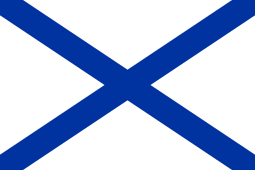 |
| Jack |  |
| Patch | 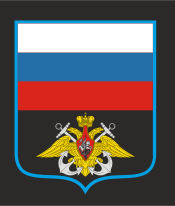 |
| Middle Emblem | 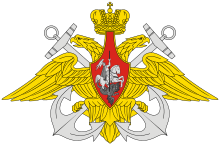 |
| Roundel |  |
| Navies of Russia |
|---|
|
The first iteration of the Russian Navy was established by Peter the Great (Peter I) in October 1696. Ascribed to him is the oft quoted statement: "A ruler that has but an army has one hand, but he who has a navy has both."[6] The symbols of the Russian Navy, the St. Andrew's ensign (seen to the right), and most of its traditions were established personally by Peter I.
The Russian Navy possesses the vast majority of the former Soviet naval forces, and currently comprises the Northern Fleet, the Pacific Fleet, the Black Sea Fleet, the Baltic Fleet, the Caspian Flotilla, 5th Operational Squadron in Middle East, Naval Aviation, and the Coastal Troops (consisting of the Naval Infantry and the Coastal Missile and Artillery Troops).
The Russian Navy suffered severely since the dissolution of the Soviet Union due to insufficient maintenance, lack of funding and subsequent effects on the training of personnel and timely replacement of equipment. Another setback is attributed to Russia's domestic shipbuilding industry which is reported to have been in decline as to their capabilities of constructing contemporary hardware efficiently. Some analysts even say that because of this Russia's naval capabilities have been facing a slow but certain "irreversible collapse".[7][8] Some analysts say that the recent rise in gas and oil prices has enabled a sort of renaissance of the Russian Navy due to increased available funds, which may allow Russia to begin "developing the capacity to modernize".[9] In August 2014, Defence Minister Sergei Shoigu said that Russian naval capabilities would be bolstered with new weapons and equipment within the next six years in response to NATO deployments in eastern Europe and recent developments in Ukraine.[10]
Origins
| Armed Forces of the Russian Federation |
|---|
.svg.png) |
| Staff |
| Services (vid) |
| Independent troops (rod) |
| Special operations force (sof) |
| Other troops |
|
| Ranks of the Russian Military |
| Uniforms of the Russian Military |
| History of the Russian military |
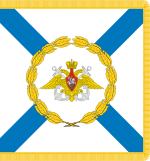
The origins of the Russian Navy can be traced back to the period between the 4th and the 6th century. The first Slavic flotillas consisted of small sailing ships and rowboats, which had been seaworthy and able to navigate in riverbeds. During the 9th through 12th centuries, there were flotillas in the Kievan Rus' consisting of hundreds of vessels with one, two, or three masts. Riverine vessels in 9th century Kievan Rus guarded trade routes to Constantinople.[11] The citizens of Novgorod are known to have conducted military campaigns in the Baltic Sea (e.g., the siege of Sigtuna in 1187)—although contemporary Scandinavian sources state that the fleet was from Karelia or Estonia.[12] Lad'ya (ладья in Russian or sea boat) was a typical boat used by the army of Novgorod (length 30 meters with a width of five to six meters, and two or three masts, with the armament of battering rams and catapults, complement: 50 to 60 men). There were also smaller sailboats and rowboats, such as ushkuys (ушкуи) for sailing in rivers, lakes and skerries, kochis (кочи), and nosads (носады), used for cargo transportation.
During the 16th and 17th centuries, the Cossacks conducted military campaigns against the Crimean Khanate and the Ottoman Empire, using sailboats and rowboats. The Don Cossacks called them strugs (струг). These boats were capable of transporting up to 80 men. The Cossack flotillas numbered 80 to 100 boats. The centralized Russian state had been fighting for its own access to the Baltic Sea, Black Sea and Sea of Azov since the 17th century. By the end of that century, the Russians had accumulated some valuable experience in using riverboats together with land forces.
Under Tsar Mikhail Feodorovich, the construction of the first three-masted ship to be built entirely within Russia was finished in 1636. She was built in Balakhna by Danish shipbuilders from Holstein with a European design. She was christened the Frederick. In 1667–69, the Russians tried to build naval ships in a village of Dedinovo on the shores of the Oka River for the purpose of defending the trade routes along the Volga River, which led to the Caspian Sea. In 1668, they built a 26-gun ship, the Oryol (Орёл, or eagle), a yacht, a boat with a mast and bowsprit, and a few rowboats.
During much of the seventeenth century Russian merchants and Cossacks, using koch boats, sailed across the White Sea, explored the rivers Lena, Kolyma and Indigirka, and founded settlements in the region of the upper Amur. Unquestionably the most celebrated Russian explorer was Semyon Dezhnev, who, in 1648, sailed the entire length of present-day Russia along the Arctic coast. Rounding the Chukotsk Peninsula, Dezhnev passed through the Bering Sea and sailed into the Pacific Ocean.
Imperial Russian Navy
The modern Russian Navy was created at the initiative of Peter the Great. During the Second Azov campaign of 1696 against the Ottoman Empire, the Russians employed for the first time 2 warships, 4 fireships, 23 galleys and 1300 strugs, built on the Voronezh River. After the Azov fortress was taken, at Peter I's request the Boyar Duma, understanding the vital importance of a navy for successful warfare, on 20 October 1696 adopted a decree on commencing the construction of a regular navy.[13][14]
Early on in his reign, Peter made a tour to western Europe, England, and the Netherlands. In the Netherlands, he became acquainted with the work of the mathematicians Hans Gouda, Dirk Raven, and Hans Isbrandtsen Hoogzaat, which sparked his enthusiasm for the value of mathematics. A major result of this tour was the hiring of large numbers of foreign specialists of various expertise, including mathematicians. Among those hired was Henry (or Harry) Farquharson, called in Russia Andrei Danilovich (Daniloff) Farkhvarson or Farvarson (1675–1739), who had taught mathematics and astronomy at the University of Aberdeen and was recommended by Halley and Jacob Daniel Bruce (1670–1735), while John Colson was hired to teach mathematics. Farquaharson's task in Russia was to create and administer a School of Mathematics and Navigation. It was under Farquharson's guidance that he and Tsar Peter wrote the mathematics curriculum for the new school. He was accompanied by Stephen Gwyn (1684–1720) and Richard Grice (1682?–1709), who were graduates of the England's Royal Mathematical School. In 1700 at Voronezh the first major ships launched for the fledgling Russian Navy—for use with the Azov Fleet—were the 58-gun Goto Predestinatsiya (God's Providence), the 80-gun Staryy Orel (Old Eagle), and the 70-gun Staryy Dub (Old Oak).[13]
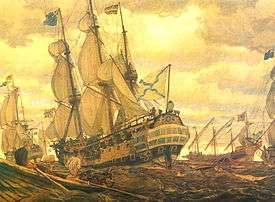
During the Great Northern War of 1700–1721, the Russians built the Baltic Fleet and the city of St. Petersburg. In 1703–1723, the main base of the Baltic Fleet was located in St. Petersburg and then in Kronshtadt. Other bases were later established in Vyborg, Helsingfors, Revel (now Tallinn) and Åbo. At first, the Vladimirskiy Prikaz was in charge of shipbuilding. Later on, these functions were transferred to the Russian Admiralty.
Basic principles of the Russian Navy, its educational and training methods, as well as methods for conducting military action were all summarized in the Naval Regulations (1720) penned by Peter the Great. Peter, Feodor Apraksin, Alexey Senyavin, Naum Senyavin and Mikhail Golitsyn are generally credited for the development of the Russian art of naval warfare. Main principles of naval warfare were further developed by Grigoriy Spiridov, Feodor Ushakov, and Dmitriy Senyavin.
The Russo-Turkish Wars of Catherine the Great resulted in the establishment of the Black Sea Fleet, with its bases in Sevastopol (1783) and Kherson. It was at that time that Russian warships started to venture into the Mediterranean on a regular basis. In 1770, Grigoriy Spiridov's squadron gained supremacy in the Aegean Sea by destroying the Turkish fleet in the Battle of Chesma. After having advanced to the Danube, the Russians formed the Danube Military Flotilla for the purpose of guarding the Danube estuary from the Turks and they came in 1771 as guests to Dubrovnik in the Republic of Ragusa.[15] The Beluga caviar from the Danube was famous and the merchants from the Republic of Ragusa dominated the import-export business in Serbia with the Habsburg Monarchy.[16] The Russian Navy captured in 1780 two British cargo vessels, their cargo were hemp and iron.[17] The Republic of Ragusa became one of the chief carriers of the Mediterranean in 1783 with the help of the U.S., when Britain acknowledges the United States independence, although the Americans agreed to allow Dubrovnik's ships free passage in their ports.
During the Mediterranean expedition of 1799, Fyodor Ushakov single-handedly carved out the Greek Republic of Seven Islands, proceeding to clear from the French Corfu and all the Ionian islands. His squadron then blocked the French bases in Italy, notably Genoa and Ancona, and successfully assaultedNaples and Rome. Ushakov, proclaimed a patron saint of the Russian Navy in the 21st century, was succeeded in command by Dmitriy Senyavin who reasserted Russian control of the southern Adriatic, disrupted Dubrovnik's sea trade, and destroyed the Ottoman Fleet in the Battle of Athos (1807). Between 1803 and 1855, Russian sailors undertook over 40 circumnavigations and distant voyages, which played an important role in exploration of the Far East and culminated in Fabian Gottlieb von Bellingshausen's discovery of Antarctica.
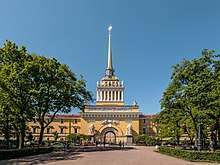
Notwithstanding these triumphs, Russia's slow technical and economic development in the first half of the 19th century caused her to fall behind other world powers in the field of steamboat construction. It was in 1826 that the Russians built their first armed steamboat Izhora. At the outbreak of the Crimean War in 1853, steamships were few and sailing ships heavily predominated. The Battle of Sinope, won by Pavel Nakhimov, is remembered in history as the last significant naval battle involving sailing ships. During the Siege of Sevastopol in 1854–1855, Russian sailors set an example of using all means possible for defending their base from land and sea. Although the Russians introduced modern naval mining in the Baltic and repelled the Siege of Petropavlovsk-Kamchatskiy in the Pacific, Sevastopol was finally surrendered on honourable terms but only after the Russians sank their ships to prevent outside use of the harbor. In accordance with the Treaty of Paris, Russia lost its right to have a military fleet in the Black Sea.
As a consequence, the Russian sailing fleet lost its significance and was rapidly replaced by steamboats, including the first steel armored gunship Opyt and one of the first seafaring ironclads Pyotr Velikiy. On 16 January 1877 Admiral Stepan Makarov became the first to launch torpedoes from a boat in combat. He also proposed the idea and oversaw the construction of the world's first ocean-going icebreaker Yermak, commanding it in two Arctic expeditions in 1899 and 1901. At about the same time, Aleksey Krylov elaborated the modern floodability theory.
The Russian Navy was considered the third strongest in the world on the eve of the Russo-Japanese War, which turned to be a catastrophe for the Russian military in general and the Russian Navy in particular. Although neither party lacked courage, the Russians were defeated by the Japanese in the Battle of Port Arthur, which was the first time in warfare that mines were used for offensive purposes. The warships of the Baltic Fleet sent to the Far East were lost in the Battle of Tsushima.
Soon after the war Russia devoted a significant portion of its military spending to an ambitious shipbuilding program aimed at replacing lost warships with modern dreadnoughts. During World War I, the fleets played a limited role in the Eastern Front, due to heavy defensive and offensive mining on both sides. Characteristically, the Black Sea Fleet succeeded in mining the Bosporus, thus preventing the Ottoman Fleet from entering the Black Sea. After the revolution forced Russia to quit the war, the Baltic Fleet was evacuated from Helsinki and Tallinn to Kronshtadt during the Ice Cruise of the Baltic Fleet and many of the ships of the Black Sea Fleet found their last refuge in Bizerte.
Soviet Navy
For the most part, Russian sailors welcomed the Russian Revolution of 1917, in which they participated. Earlier, in 1905, sailors of the battleship Potemkin in the Black Sea Navy revolted. In 1906 rebellious soldiers gained control of some Helsinki coastal fortifications during events known as the Viapori Rebellion, which was subsequently put down, following bombardments from ships of the Baltic Fleet which remained loyal to the Tsarist government. The first ship of the Soviet Navy could be considered to be the rebellious cruiser Avrora, whose blank shot from its forecastle gun signaled the October Revolution according to Soviet narratives. In March 1921, the sailors of Kronshtadt rebelled against the Bolsheviks, demanding freedom of speech and closing of concentration camps, but this belated revolt was ruthlessly suppressed by Leon Trotsky.
After the Revolution, the navy's restoration was slow, and only with the beginning of industrialisation in 1930 was a large shipbuilding program developed, but not accomplished before the beginning of the Great Patriotic War, the Soviet Union's portion of World War II. As a result, the Soviet Navy during World War II consisted of some old World War I-era ships, some modern pre-war built cruisers and destroyers, and a number of torpedo boats. Unfortunately, much of the Soviet fleet on the Baltic Sea was blocked in Leningrad and Kronshtadt by Finnish and German minefields during 1941–1944 and maimed by mines and air attacks, nevertheless numerous sorties by attack boats and submarines actions were conducted. On the Black Sea with the loss of the main naval base—Sevastopol, and effective actions of axis aviation as well as minefields the effectiveness of large surface ships was limited. The Northern Fleet, composed mostly of destroyers (World War I Novik-class and more modern Design 7 and 7U vessels), played a role in anti-aircraft and anti-submarine defence of allied convoys heading to Murmansk.
During the Cold War, the Soviets gave their navy a number of missions, in addition to its role as one of the legs of the nuclear triad, the navy was supposed to destroy American SSBNs and carrier groups, interdict NATO lines of communications, and assist the ground forces in continental theatre offensives.[18] They were quick to equip their surface fleet with missiles of various sorts. In fact, it became a hallmark of Soviet design to place large anti-ship missiles onto relatively small and fast missile boats. The Soviet Navy also possessed several very large guided missile cruisers with great firepower, such as those of the Kirov-class and the Slava-class cruisers. In the 1980s the Soviet Navy acquired its first true aircraft carrier, Tbilisi (subsequently renamed Fleet Admiral of the Soviet Union Kuznetsov).[19]
In some respects, including speed and reactor technology, later Soviet submarines were, and remain, some of the world's best. Their primary shortcomings were insufficient noise damping (American boats were quieter) and sonar technology. The Soviets possessed numerous purpose-built guided missile submarines, such as the Oscar-class submarine, as well as many ballistic missile submarines, such as the Delta-class submarines, and attack submarines, such as the Victor and Akula-class submarine. The Soviet Navy's Typhoon-class ballistic missile boats are the world's largest submarines. The Soviet attack submarine force was, like the rest of the navy, geared towards the forward intercept and destruction of US/NATO naval forces, especially American aircraft carrier battle groups.
Russian Federation Navy
The 1991 dissolution of the Soviet Union led to a severe decline in the Russian Navy. Defense expenditures were severely reduced. Many ships were scrapped or laid up as accommodation ships at naval bases, and the building program was essentially stopped. Sergey Gorshkov's buildup during the Soviet period had emphasised ships over support facilities, but Gorshkov had also retained ships in service beyond their effective lifetimes, so a reduction had been inevitable in any event.[20] The situation was exacerbated by the impractical range of vessel types which the Soviet military-industrial complex, with the support of the leadership, had forced on the navy—taking modifications into account, the Soviet Navy in the mid-1980s had nearly 250 different classes of ship.[21] The Kiev-class aircraft carrying cruisers and many other ships were prematurely retired, and the incomplete second Admiral Kuznetsov-class aircraft carrier Varyag was eventually sold to the People's Republic of China by Ukraine. Funds were only allocated for the completion of ships ordered prior to the collapse of the USSR, as well as for refits and repairs on fleet ships taken out of service since. However, the construction times for these ships tended to stretch out extensively: in 2003 it was reported that the Akula-class submarine Nerpa had been under construction for fifteen years.[22]
Storage of decommissioned nuclear submarines in ports near Murmansk became a significant issue, with the Bellona Foundation reporting details of lowered readiness. Naval support bases outside Russia, such as Cam Ranh Bay in Vietnam, were gradually closed, with the exception of the modest technical support base in Tartus, Syria to support ships deployed to the Mediterranean. Naval Aviation declined as well from its height as Soviet Naval Aviation, dropping from an estimated 60,000 personnel with some 1,100 combat aircraft in 1992 to 35,000 personnel with around 270 combat aircraft in 2006.[23] In 2002, out of 584 naval aviation crews only 156 were combat ready, and 77 ready for night flying. Average annual flying time was 21.7 hours, compared to 24 hours in 1999.[24]
Training and readiness also suffered severely. In 1995, only two missile submarines at a time were being maintained on station, from the Northern and Pacific Fleets.[25] The decline culminated in the loss of the Oscar II-class Kursk submarine during the Northern Fleet summer exercise that was intended to back up the publication of a new naval doctrine.[26] The exercise was to have culminated with the deployment of the Admiral Kuznetsov task group to the Mediterranean.
As of February 2008, the Russian Navy had 44 nuclear submarines with 24 operational; 19 diesel-electric submarines, 16 operational; and 56 first and second rank surface combatants, 37 operational.[27] Despite this improvement, the November 2008 accident on board the Akula-class submarine attack boat Nerpa during sea trials before lease to India represented a concern for the future.[28]
In 2009 Admiral Popov, former commander of the Russian Northern Fleet, said that the Russian Navy would greatly decline in combat capabilities by 2015 if the current rate of new ship construction remained unchanged, due to the retirement of ocean-going ships.[29]
In 2012, President Vladimir Putin announced a plan to build 51 modern ships and 24 submarines by 2020.[30] Of the 24 submarines, 16 will be nuclear-powered.[31] On 10 January 2013, the Russian Navy finally accepted its first new Borei-class SSBN (Yury Dolgorukiy) for service.[32] A second Borei (Aleksandr Nevskiy) was undergoing sea trials and entered service on 21 December 2013.[33] A third Borei-class boat (Vladimir Monomakh) was launched and began trials in early 2013, and was commissioned in late 2014.[34]
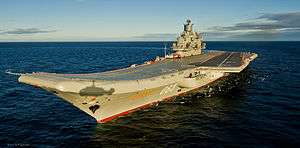 Admiral Kuznetsov, the flagship of the Russian Navy
Admiral Kuznetsov, the flagship of the Russian Navy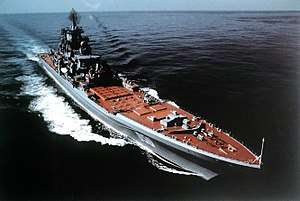 Kirov-class battlecruiser
Kirov-class battlecruiser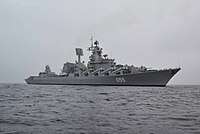 Slava-class cruiser
Slava-class cruiser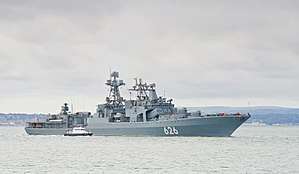 Udaloy-class destroyer
Udaloy-class destroyer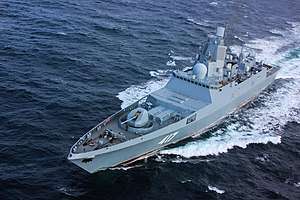
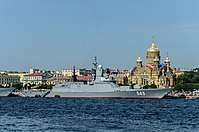 Steregushchy-class corvette
Steregushchy-class corvette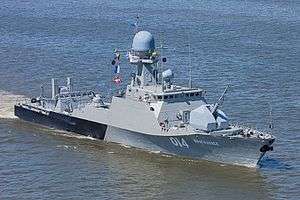
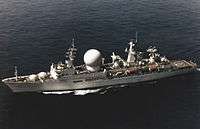 Missile range instrumentation ship Marshal Krylov
Missile range instrumentation ship Marshal Krylov
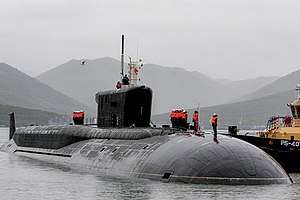 Borei-class (Dolgorukiy-class) submarine
Borei-class (Dolgorukiy-class) submarine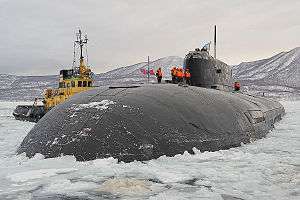
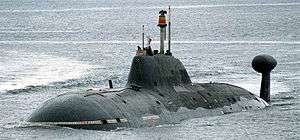 Akula-class submarine Vepr (K-157)
Akula-class submarine Vepr (K-157)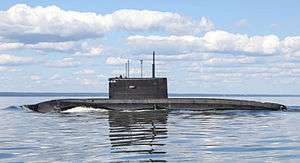
Leadership
.jpg)
- 1992 – November 1997, FADM Feliks Gromov
- November 1997 – September 2005, FADM Vladimir Kuroyedov
- September 2005 – September 2007, FADM Vladimir Masorin
- September 2007 – May 2012, ADM Vladimir Vysotsky
- May 2012 – February 2016, ADM Viktor Chirkov
- February 2016 – May 2019, ADM Vladimir Korolyov
- May 2019 – present, ADM Nikolai Yevmenov
Structure
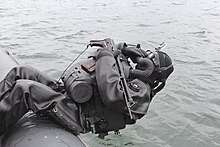
Since 2012 the headquarters of the Russian Navy (Russian Navy Main Staff) is once again located in the Admiralty in Saint Petersburg. Russian naval manpower is a mixture of conscripts serving one-year terms and volunteers (Officers and Ratings). In 2006 the IISS assessed there were 142,000 personnel in the Russian Navy. As of 2008 the conscription term was reduced to one year and a major downsizing and reorganization were underway. In 2008, plans were announced to move the headquarters to the Admiralty building in St. Petersburg, the historic location of the headquarters of the Imperial Russian Navy. The Navy Staff finally relocated there in November 2012.[35]
The Russian Navy is organised into four combat services - the Surface Forces, the Submarine Forces, the Naval Aviation and the Coastal Troops.[36] Additionally the navy also includes support units afloat and ashore. It does not include special forces. The Naval Spetsnaz brigades are part of the Main Intelligence Directorate attached to the respective fleets and the Counter-Diversionary Forces and Assets (ПДСС) (which are units, protecting the Navy from incursions of enemy special forces) fall within the Coastal Forces.
During the Cold War the Soviet Armed Forces made the distinction between the various naval commands. The main fleets were the Northern and the Pacific Fleet. They were tasked with independent operations on the high seas and for that reason included strategic surface, submarine and air forces, including the country's naval nuclear deterrent. Due to the limited geography of the Baltic and the Black Seas the respective Baltic and Black Sea Fleets were given a more circumspect role in support of adjacent ground formation (the Main Command of the Troops of the Western Direction in Legnica (Poland) and the Main Command of the Troops of the South-Western Direction in Chișinău. These two fleets were armed with shorter-range weapon systems than the main fleets (diesel-electric submarines, Sukhoi Su-24 fighter-bombers and a larger quantity of frigates and corvettes). Due to the closed nature of the Caspian Sea (still connected to the Baltic and Black Seas through the Volga River and the system of rivers and canals and navigable for ships of corvette size) its Caspian Flotilla had an even more limited role than the Fleets and played a defensive role supporting the Main Command of the Troops of the Southern Direction in Baku.
With the end of the Cold War a significant reduction in forces followed. Before the 2008 Russian military reform, the four fleets were ranked as equal in status to the six Military Districts. With the reform measures going into force the number of Military Districts was reduced and became new Joint Strategic Commands and the four fleets and one flotilla were subordinated to them with status equal to the Ground Forces and the Air Forces armies. Due to Russia's increased interests in the Arctic region and the importance of Russia's western/northwestern maritime defense the Northern Fleet, originally part of the Joint Strategic Command West (Western Military District), on 12 December 2014 became the basis for the newly formed fifth Northern Fleet Joint Strategic Command/Military District.
Submarine and surface forces
The submarine and surface forces form the backbone of the Navy. The submarines form part of dedicated submarine squadrons and flotillas or part of squadrons and flotillas of mixed compsition together with major surface combatants. The Russian Navy retains a rigid structure, whose levels of command could, according to military regulations, be directly equaled to the corresponding ground and air forces counterparts:
| Part of | Fleet unit | Officer commanding | Ground and air forces equivalent | Officer commanding | Notes |
|---|---|---|---|---|---|
| General Staff of the Armed Forces of the Russian Federation | Chief Commander of the Navy
(Главнокомандующий Военно-морским флотом Российской Федерации) |
Admiral | Chief Commander of the Land Forces
(Главнокомандующий Сухопутными войсками Российской Федерации) Chief Commander of the Aerospace Forces (Главнокомандующий Воздушно-космическими силами Российской Федерации) |
Colonel general | |
| Chief of Staff and First Deputy Commander of the Navy
(Начальник штаба — первый заместитель Главнокомандующего ВМФ) |
Vice admiral | Chief of the Main Staff and First Deputy Commander of the Land Forces
(Начальник Главного штаба Сухопутных войск — первый заместитель главнокомандующего Сухопутными войсками) Chief of the Main Staff and First Deputy Commander of the Aerospace Forces (Начальник Главного штаба — первый заместитель Главнокомандующего Воздушно-космическими силами) |
Lieutenant general | ||
| Deputy Commander of the Navy
(Заместитель Главнокомандующего ВМФ) |
Vice admiral /
Lieutenant general (Marines and Naval Aviation) |
Deputy Commander of the Land Forces
(Заместитель Главнокомандующего СВ) Deputy Commander of the Aerospace Forces (Заместитель Главнокомандующего ВКС) |
Lieutenant general | ||
| Northern Fleet Joint Strategic Command | Commander of the Northern Fleet
(Командующий Северным флотом) |
Admiral |
|
Colonel general | |
| Eastern Military District | Commander of the Pacific Fleet
(Командующий Тихоокеанским флотом) |
||||
| Western Military District | Commander of the Baltic Fleet
(Командующий Балтийским флотом) |
Vice admiral | Lieutenant general | ||
| Southern Military District | Commander of the Black Sea Fleet
(Командующий Черноморским флотом) |
||||
| Commander of the Caspian Flotilla
(Командующий Каспийской флотилией) |
Kontradmiral |
|
Major general | ||
| Fleet
(Флот) |
Flotilla
(Флотилия) |
Kontradmiral | Used to correspond to a ground forces or air forces Army.
|
Major general | Could be separate Flotilla or one forming part of a Fleet. For example, the modern day Primorskaya Mixed Forces Formation (formerly Mixed Forces Flotilla) of the Pacific Fleet. |
| Fleet
(Флот) |
Operational Squadron
(Оперативная эскадра) |
Kontradmiral |
|
Major general | Naval Task Force. For example, the 5th Operational Squadron. |
| Fleet
(Флот) |
Squadron (ships)
(Эскадра) |
Kontradmiral |
|
Major general | A permanent formation, combining several divisions and brigades. Equal to an Army Corps. |
| Squadron (ships) | Division of major ships
(Дивизия кораблей) |
Kontradmiral | Division | Major general | For example, the Black Sea Fleet's 30th Surface Ships Division or the Northern Fleet's 7th Submarine Division. |
| Fleet
(Флот) |
Naval Base
(Военно-морская база) |
Kontradmiral | Division | Major general | A Naval Base is a command of divisional level, which is subordinated to a Fleet or Flotilla. It provides berthing, supply and repair to the Fleet's main forces, as well as defence against conventional and asymmetric threats. For that reason it includes a Brigade of ships of at least one missile corvette division and one minesweeper division. The base also deploys counter-diversion combat divers and possibly a coastal defence ground formation of marines and coastal artillery. The Naval Base could include a main base location and one or more secondary locations, in which case the secondary locations would deploy a mixed division of corvettes/ fast attack craft and minesweepers. |
| Squadron (ships) /
Naval Base |
Brigade of ships
(Бригада кораблей) |
Kontradmiral / | Brigade | Major general / |
|
| Division of major ships
(Дивизия кораблей) |
Division of warships of 2nd rank
(Дивизион кораблей 2-го ранга) |
Captain 1st Rank | Regiment /
Air Regiment |
Colonel | Increasingly out of use as in modern days warships 2nd class form ships brigades and ships divisions. |
| Division of major ships
(Дивизия кораблей) / Brigade of ships (Бригада кораблей) |
Division of warships of 3rd rank
(Дивизион кораблей 3-го ранга) |
Captain 2nd rank | Separate Battalion /
Air Squadron |
Lieutenant colonel | Division of corvettes. |
| Brigade of ships
(Бригада кораблей) / Naval Base (Военно-морская база) |
Division of warships of 4th rank
(Дивизион кораблей 4-го ранга) |
Captain 3rd rank | Separate Battalion /
Air Squadron |
Major | Division fast craft or minesweepers. |
| Brigade of ships
(Бригада кораблей) / Naval Base (Военно-морская база) |
Division of warships of 4th rank
(Дивизион кораблей 4-го ранга) |
Captain 3rd rank / | Separate Company / Separate Battery /
Air Flight |
Captain | In case of a division of small support craft of a naval base, such as tug boats, fire boats, courier launches etc. |
| Individual ships | |||||
| Division of major ships
(Дивизия кораблей) / Brigade of ships (Бригада кораблей) |
Warship 1st rank | Captain 1st Rank | Regiment /
Air Regiment
|
Colonel |
|
| Brigade of ships
(Бригада кораблей) / Division of small ships (Дивизион кораблей) |
Warship 2nd rank | Captain 2nd rank | Separate Battalion /
Air Squadron
|
Lieutenant colonel | |
| Division of ships 3rd rank
(Дивизион кораблей 3-го ранга) |
Warship 3rd rank | Captain 3rd rank | Separate Battalion /
Air Squadron
|
Major | |
| Division of ships 4th rank
(Дивизион кораблей 4-го ранга) |
Warship 4th rank | Captain lieutenant / | Platoon | Captain / |
|
Coastal troops
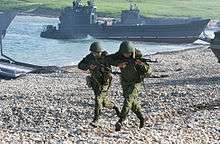
Coastal Troops include the Naval Infantry and the Coastal Missile and Artillery Troops.
The Russian Naval Infantry are the amphibious force of the Russian Navy and can trace their origins back to 1705, when Peter the Great issued a decree for an infantry regiment "of naval equipage". Since its formation it has seen action in the Napoleonic Wars, the Crimean War, the Russo-Japanese War, the First and Second World Wars, and the Chechen and Georgian conflicts. Under the leadership of Admiral Gorshkov during the Cold War, the Soviet Navy expanded the reach of the Naval Infantry and deployed it worldwide on numerous occasions, but since the dissolution of the Soviet Union its role has been greatly reduced.
The Soviet Naval Infantry and their Russian successors have a reputation as elite shock troops. For their black uniforms and ferocious performance in combat in the Black Sea and Baltic Sea regions during World War II they received the nickname "The Black Death" (German: der schwarze Tod). The Russian Naval Infantry is a mechanised force, organised in brigades, independent regiments and independent battalions. The 55th Naval Infantry Division of the Pacific Fleet has been disbanded in 2009 and replaced by two separate brigades. Each brigade has a tank battalion, a self-propelled artillery battalion, a self-propelled air defence battalion, mechanised marine infantry battalions, other support units and one Airborne Assault Naval Infantry Battalion (десантно-штурмовой батальон морской пехоты), parachute and air assault qualified, with the mission to spearhead amphibious landings.
The coastal defence troops of the Russian Navy are conventional mechanised brigades with the main task to prevent enemy amphibious landings. An example of coastal defence troops are those of the Baltic Fleet. With Estonia, Latvia and Lithuania declaring independence at the end of the Soviet Union the Baltic Military District practically disintegrated. The massive ground forces formations left landlocked in the Kaliningrad Oblast were transferred from the ground forces to naval command and control. The integration of naval infantry and coastal defence troops is a relatively new tendency from the 2010s in order to simplify the naval command structure and the new Arctic infantry brigades in formation under the Northern Fleet Joint Strategic Command fall within that process.
The coastal artillery troops also play a very important role for the Navy. The geography of the Barents Sea, the Baltic Sea, the Black Sea and the Sea of Okhotsk as well as the Caspian Sea makes the deployment of shore-based, anti-ship systems in an area-denying role very effective. They deploy K-300P Bastion-P supersonic ASCM, 3M-54 Kalibr cruise subsonic ASCM and A-222E Bereg-E 130mm coastal mobile artillery system as well as self-propelled surface-to-air missile systems.
The Naval Infantry and Coastal Troops are led by the Deputy Commander for Naval Infantry/Commandant of the Naval Infantry of the Russian Navy, Major General (NI) Aleksandr Kolpatsenko. Their motto is: "Where We Are, There is Victory!"
Naval aviation
_DD-SD-99-06153.jpg)
The first naval aviation units in Russia were formed from 1912 through 1914 as a part of the Soviet Baltic Fleet and the Soviet Black Sea Fleet. Since its formation, it has participated in the Russian Civil War, World War II and in many other conflicts throughout Europe, the Middle East and Asia (statement requires source citation). During the Cold War the naval aviation pursued a policy of deploying large numbers of bombers in maritime strike roles to counter the U.S. Navy's extensive fleet of aircraft carriers, by 1989 it operated over 1,000 fixed-wing aircraft with the majority being bombers such as the Tu-22M "Backfire" and the Tu-16 "Badger".[37] Since the fall of the Soviet Union however, it has been significantly reduced in size. The Tu-22Ms have been transferred to the Aerospace Forces and since then the combat arm of the Naval Aviation is built around Sukhoi Su-33s, Mikoyan MiG-29Ks, with Sukhoi Su-30s and Sukhoi Su-34s replacing the obsolete Sukhoi Su-24s.
As of 2007, the Russian Naval Aviation consists of the following components:[38]
- Naval missile-carrying aviation
- Shore-based ASW aviation
- Attack (Shturmovik) aviation
- Shore-based fighter aviation
- Reconnaissance aviation
- Shipborne aviation (fighters and ASW aircraft)
- Auxiliary air units
Prefixes
Neither Jane's Fighting Ships nor the International Institute for Strategic Studies list any standard ship prefixes for the vessels of the Russian Navy. The U.S. government sometimes uses the exonymous prefix "RFS" (for "Russian Federation Ship"). However, the Russian Navy itself does not use this convention.
Equipment
Ships and submarines
Aircraft
Military districts and fleets
The Russian Navy consists of four fleets and one flotilla with 3 of 4 fleets and the Caspian Flotilla subordinated to the newly formed Military Districts-Joint Operational Strategic Commands.
Joint Strategic Command Northern Fleet
Northern Fleet
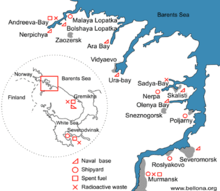
The Russian Northern Fleet, established as a modern formation in 1933, is headquartered at Severomorsk and spread around various bases in the greater Murmansk area. It is the main fleet of the Russian Navy and currently comprises[39]
- Admiral Kuznetsov (1)
- Kirov-class battlecruiser (2)
- Slava-class cruiser (1)
- Udaloy II-class destroyer (1)
- Udaloy-class destroyer (4)
- Sovremennyy-class destroyer (2)
- Admiral Gorshkov-class frigate (1)
- Grisha-class corvette (6)
- Nanuchka-class corvette (3)
- Dolgorukiy-class submarine (1)
- Delta IV-class submarine (6)
- Typhoon-class submarine (1)
- Oscar-class submarine (3)
- Yasen-class submarine (1)
- Akula-class submarine (6)
- Sierra-class submarine (3)
- Victor III-class submarine (3)
- Lada-class submarine (1)
- Kilo-class submarine (5)
The Northern Fleet also includes many corvettes, patrol ships, light amphibious ships and support and logistic ships.
Western Military District – Western Joint Strategic Command
Baltic Fleet

The Baltic Fleet, established on 18 May 1703, is based in Baltiysk and Kronshtadt, with its headquarters in the city of Kaliningrad, Kaliningrad Oblast. The Fleet consists of;[39]
- Sovremennyy-class destroyer (1)
- Neustrashimyy-class frigate (2)
- Steregushchiy-class corvette (4)
- Buyan-M-class corvette (2)
- Kilo-class submarine (2)
The Baltic Fleet also includes many corvettes, patrol ships, minehunters, light amphibious ships and support vessels.
Southern Military District – Southern Joint Strategic Command
Black Sea Fleet
The Black Sea Fleet, established on 2 May 1783, is based at the Sevastopol, Karantinnaya, and Streletskaya Bays in Sevastopol which is also the location of its headquarters, and at Novorossiysk in Krasnodar Kray. The fleet also has various other facilities on the Crimean Peninsula and facilities in Krasnodar Kray. The Fleet consists of;[39]
- Slava-class cruiser (1)
- Kashin-class destroyer (1)
- Admiral Grigorovich-class frigate (3)
- Burevestnik (Krivak)-class frigate (2)
- Kilo-class submarine (6)
The Black Sea Fleet also includes a small number of corvettes, patrol and coastal protection ships, light amphibious ships, and support vessels.
Caspian Flotilla
The Caspian Flotilla, established on 4 November 1722, is based in Astrakhan and Makhachkala with its headquarters in Astrakhan. The Fleet consists of;[39]
The Caspian Flotilla also includes 4 artillery and 3 rocket corvettes and some patrol ships.
Eastern Military District – Eastern Joint Strategic Command
Pacific Fleet
The Pacific Fleet, established on 10 May 1731, is headquartered in Vladivostok and based around Vladivostok and Petropavlovsk-Kamchatskiy. The Fleet consists of;[39]
- Slava-class cruiser (1)
- Sovremennyy-class destroyer (1)
- Udaloy-class destroyer (4)
- Steregushchiy-class corvette (2)
- Dolgorukiy-class submarine (2)
- Delta III-class submarine (3)
- Oscar-class submarine (5)
- Akula-class submarine (5)
- Kilo-class submarine (7)
The Pacific Fleet also includes coastal combatants such as corvettes, patrol ships, mine warfare ships, light amphibious ships, and support vessels. There are also naval aviation and coastal troops and naval infantry components.
Future and modernization
Russia's military budget expanded from 1998 until 2015, but economic problems including a sharp decline in oils led to budget cuts in 2016.[40] Higher expenditure led to an increase in numbers of ships under construction, initially focusing on submarines, such as the conventional Petersburg (Lada)-class and nuclear Severodvinsk (Yasen)-class. Some older vessels have been refitted as well. Jane's Fighting Ships commented in 2004 that the construction programme was too focused on Cold War scenarios, given the submarine emphasis.[41] According to the Russian Defense Ministry, share of modern armament in the Navy has reached more than 50% in 2014.[42] A report from December 2019 estimated the figure at 68%.[43][44][45][46]
The Steregushchiy-class corvettes, the lead ship of which was laid down on 21 December 2001, is the first new surface construction since the collapse of the Soviet Union,[47] while the new Admiral Sergei Gorshkov class frigates marks the first attempt of the Navy to return to the construction of large blue water capable vessels.[48] The Russian Navy plans to procure two new classes of destroyer, the general-purpose Project 21956 in the 2010s and the Leader-class anti-air destroyer in the 2020s. The latter will likely carry the S-500 anti-ballistic missile system.[49]
A rearmament program approved in 2007 placed the development of the navy on an equal footing with the Strategic Missile Forces for the first time in Soviet and Russian history. This program, covering the period until 2015, expected to see the replacement of 45 percent of the inventory of the Russian Navy.[50] Out of 4.9 trillion rubles ($192.16 billion) allocated for military rearmament, 25 percent will go into building new ships. "We are already building practically as many ships as we did in Soviet times," First Deputy Prime Minister Sergei Ivanov said during a visit to Severodvinsk in July 2007, "The problem now is not lack of money, but how to optimize production so that the navy can get new ships three, not five, years after laying them down."[51]
On 28 April 2010, the Ukrainian parliament ratified an agreement to extend Russia's lease of Crimean base facilities to 2042 with an option for five more years, through 2047.[52] Subsequent to the annexation of Crimea by Russia in 2014, this agreement has been officially invalidated by the Russian State Duma. The Russian Navy has also revealed that the Russia's Black Sea Fleet will receive 30 new ships by 2020 and will become self-sufficient with its own infrastructure in the Crimean peninsula. The fleet will be updated with new warships, submarines, and auxiliary vessels within the next six years. The new ships being built for the Black Sea Fleet include six Admiral Grigorovich-class frigates and six Varshavyanka-class (Improved Kilo-class) diesel-electric submarines.[53]
On 27 December 2015, state-owned United Shipbuilding Corporation declared that by 2019 the company would have the technical ability to build aircraft and helicopter carriers, which came as some surprise to analysts as previously the company had stated carrier-building would not take place until 2025 at the earliest. Russia's only existing carrier, the Soviet era Admiral Kuznetsov will remain in service at least until 2030.[54]
In a May 2017 ten year defence review the development of a new aircraft carrier and nuclear powered destroyers was cancelled in favour of concentrating modernisation efforts on the nuclear triad. Development of a sixth generation SSBN was announced even though the fifth generation Borei class are still under construction as was a fleet of sub-frigate sized surface combatants.[55]
Main Naval Parade in St. Petersburg
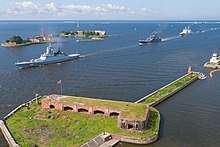
Since 2017, by the decree of the President of Russia dated 27 July 2017,[56] the tradition of holding the Main Naval Parade in St. Petersburg on the Navy Day has been restored. The parade is composed of ships and sailors representing the several fleets and the Caspian Flotilla with small ships and submarines in the Neva River and the larger ones arrayed off Kronshtadt in the Gulf of St. Petersburg. It is celebrated annually on the last Sunday of July during the Navy Day holiday.
Deployments and increase in activity
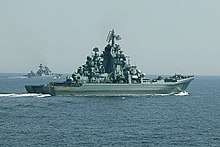
In the last years of the 1990s naval activity was very low. Even at the height of the Kosovo War, a planned task group deployment to the Mediterranean was reduced to the dispatch of the intelligence ship Liman. 2003 saw a major increase in activity, including several major exercises. A May joint exercise with the Indian Navy saw two Pacific Fleet destroyers and four vessels from the Black Sea Fleet, led by the Slava-class cruiser Moskva, deployed for three months into the Indian Ocean. The largest out-of-area deployment for a decade, the INDRA 2003 exercise, was highlighted by a series of missile launches by two Tu-160s and four Tu-95s, which made a 5,400-mile (8,700 km) round trip flight from Engels-2 air base near Saratov to the exercise area.[57]
In August 2003 the Navy also participated in the Far Eastern exercise Vostok 2003, which saw the Slava-class cruiser Varyag and the Sovremennyy-class destroyer Bystryy active, as well as an amphibious landing carried out by three Pacific Fleet Ropucha class landing ships. Warships and helicopters from the Japanese and South Korean navies also took part. The Northern Fleet followed in January 2004 when thirteen ships and seven submarines took part in exercises in the Barents Sea. The involvement of Admiral Kuznetsov and nuclear-powered cruiser Pyotr Velikiy was overshadowed however by two ballistic missile launch failures, made more embarrassing because President Vladimir Putin was afloat aboard the Typhoon-class SSBN Arkhangelsk to witness the tests. Neither of the Delta IV-class Novomoskovsk nor Kareliya were able to successfully launch what were apparently RSM-54 SLBMs.[58] Former navy commander-in-chief Vladimir Kuroyedov's early dismissal may have resulted from these gaffes. He was replaced by Admiral Vladimir Masorin in September 2005.
Embarrassment for the navy had continued, with a mine accident during rehearsals for the Baltic Fleet's celebration of Navy Day in St. Petersburg in July 2005 and the Priz-class mini-submarine AS-28 having to be rescued by a joint British/U.S. effort using a Royal Navy unmanned submersible in the Far East in early August 2005. However exercises and operations continued; Peace Mission 2005 in August 2005 involved a new level of cooperation between Russia and the Chinese People's Liberation Army Navy. Two months later the Slava-class cruiser Varyag led Russian participation in INDRA 2005, held off Visakhapatnam between 14 and 20 October 2005. It included surface firings, air defence, and anti-submarine warfare (ASW) exercises.[59]
Admiral Vladimir Vysotskiy became Commander-in-Chief of the Russian Navy on 11 September 2007, having moved up from the Northern Fleet, which he had commanded since September 2005.[60]
On 16 October 2008, the speaker of Russia's upper house of parliament did not preclude Russia asking for a resumption of a naval presence in Yemen. Authorities in the Middle East country had been calling on Moscow to help fight piracy and possible terrorist threats. The U.S.S.R. had a major naval support base on Socotra Island of the former socialist state of South Yemen, which merged with North Yemen in 1990 to form the present-day Yemen. Speaking to journalists in Sanaʽa, the capital of Yemen, Federation Council Speaker Sergey Mironov said the new direction of Russia's foreign and defense policies and an increase in its naval missions would be taken into consideration when making a decision on the request. "It's possible that the aspects of using Yemen ports not only for visits by Russian warships, but also for more strategic goals will be considered," he said. Mironov also said a visit to Russia by the president of Yemen, Ali Abdullah Saleh, could take place in the near future and that the issue of military technical cooperation could be raised during his visit.[61] Security Council chief Nikolay Patrushev said on 6 August 2012 that Russia will build a string of naval bases along its northern coast in the Arctic zone to serve as resupply bases for Russian warships and border guard vessels.[62]
Western Atlantic and U.S. eastern seaboard
- In August 2009, the news media reported that two Akula-class submarine operated off the East Coast of the United States, with one of the submarines being identified as a Project 971 Shchuka-B type. U.S. military sources noted that this was first known Russian submarine deployment to the western Atlantic since the end of the Cold War, raising concerns within U.S. military and intelligence communities.[63] The U.S. Northern Command confirmed that this 2009 Akula-class submarine deployment did occur.[64]
- In August 2012, the news media published an unconfirmed report that another Akula-class submarine operated in the Gulf of Mexico purportedly undetected for over a month, sparking controversy within U.S. military and political circles, with U.S. Senator John Cornyn of the Senate Armed Services Committee demanding details of this deployment from Admiral Jonathan W. Greenert, the Chief of Naval Operations.[65] ADM Greenert stated that no Russian submarine had operated in the Gulf of Mexico.[66]
North Atlantic and Mediterranean Sea
- In February 2008 a Russian naval task force completed a two-month deployment in the Mediterranean Sea and the North Atlantic which started on 4 December 2007. The operation was the first large-scale Russian Navy deployment to the Atlantic and the Mediterranean in 15 years. The task force included the Admiral Kuznetsov-class aircraft carrier Admiral Kuznetsov, the Udaloy-class destroyers Admiral Levchenko and Admiral Chabanenko, and the Slava-class guided missile cruiser Moskva, as well as auxiliary vessels. During the operation the navy practiced rescue and counter-terror operations, reconnaissance, and missile and bomb strikes on the (theoretical) enemy's naval task force. Over 40 Russian Air Force aircraft took part in joint exercises with the navy as well.[67][68][69] Vice-Admiral Nikolai Maksimov, the Northern Fleet commander, said during the operations that the deployment was aimed at ensuring Russia's naval presence "in key operational areas of the world's oceans" and establishing conditions for secure Russian maritime navigation. "After this visit to the Mediterranean and France, the first in 15 years, we will establish a constant presence in the region" he said.[67][68] Admiral Vladimir Vysotskiy summed up the results in February saying: "What is important is that we have appeared [in the Atlantic and the Mediterranean] at a scheduled time and not just that we appeared there. We'll do all we can to build up our presence where Russia has strategic interests", adding that Russia intended to carry out similar missions once every six months.[70]
- In October 2008, a naval task group from the Northern Fleet, comprising the nuclear-powered missile cruiser Pyotr Velikiy, the large ASW ship Admiral Chabanenko, and support ships, left their homeport of Severomorsk in northern Russia on 22 September and sailed into the northern Atlantic, having covered a distance of 1,000 nautical miles (1,900 km) in a week. "Having some spare time before a joint exercise with the Venezuelan navy, which is planned for November 2008, the warships will perform a number of tasks in the Mediterranean Sea and visit several Mediterranean ports, including Tripoli," the Navy's press service said in a statement. Russian warships were scheduled to participate in joint naval exercises with the Venezuelan Navy in the Caribbean on 10–14 November, in line with the 2008 training program, and in order to expand military cooperation with foreign navies.[71] These exercises actually took place on 1 December.
- 11 October 2008, Russian warships bound for Venezuela, including the nuclear-powered cruiser Pyotr Velikiy, put in at the Libyan port of Tripoli for resupply.[72][73]
- From Venezuela Petr Velikiy proceeded to a port call in Cape Town, South Africa, then participated in the INDRA-2009 exercise off western India, briefly engaged in counter-piracy operations in the Gulf of Aden, and returned to its homeport of Severomorsk in March 2009.
- A group of Pacific Fleet ships arrived in the Mediterranean Sea on 15 May 2013 having sailed from Vladivostok on 19 March 2013.[74] Admiral Panteleyev, the Ropucha-class landing ships Peresvet and Admiral Nevelskoy, the tanker Pechenga and the rescue tug Fotiy Krylov augmented the Russian Navy's grouping there, and carried out tasks in the Black Sea and Mediterranean Sea. The Pacific Fleet ships practiced activities jointly with forces from other Russian navy fleets and made a number of business calls at ports in the region, including a call at Limassol, Cyprus on 17 May 2013.[75]
- The Baltic Fleet Ropucha-class landing ships Kaliningrad, Aleksandr Shabalin and Azov arrived at Novorossiysk naval base on 14 May 13 having completed their duties in the Mediterranean. The Baltic Fleet ships spent several weeks at Novorossiysk undergoing checks and maintenance and replenishing supplies before resuming their duties in the Mediterranean.[76]
- The Northern Fleet's Udaloy-class destroyer Vice-Admiral Kulakov was reported to be heading for the Atlantic on 20 May 2013 after completing a visit to Norway. The ship had been taking part in the Russian-Norwegian Pomor-2013 exercise and is expected to take on supplies from the tanker Vyazma while at anchor in the North Sea before undertaking a lengthy voyage in the north eastern regions of the Atlantic Ocean.[77]
- On 1 June 2013, Navy Commander Adm Viktor Chirkov said that the aircraft carrier Admiral Kuznetsov is "expected to put out and perform a number of missions in an offshore oceanic zone as part of a group. Northern Fleet naval pilots will perform a number of missions on board this cruiser during the long-range mission." He also stated that the ship's deployment might be as part of a permanent operational group in the Mediterranean. In preparing for the deployment the ships' airwing would not be using the NITKA pilot training facility located in Crimea, Ukraine.[78]
- On 20 October 2016, a Northern Fleet task group headed by Admiral Kuznetsov was monitored by a fleet of least eight ships in the English Channel en route to Syria reportedly to participate in the attack on Aleppo. The British Royal Navy sent multiple ships including HMS Dragon to shadow each warship as the fleet met up with an additional two Russian warships. NATO also tasked its standing naval group SNMG1 to shadow the group and escort it through the Dover Straits towards the Mediterranean.
- On 17 February 2017, the Russian Navy surveillance vessel SSV-175 Viktor Leonov was cruising international waters off the East Coast of the United States. Viktor Leonov is outfitted with a variety of high-tech spying equipment designed to intercept signals intelligence. It first appeared off Delaware and, then moved south of the US submarine base at Groton, Connecticut collecting electronic signals.[79]
Syria
- Sequentially having lost naval support facility access in Albania, Yugoslavia, and Egypt, in 1971 the Soviet Navy began operating from a leased facility in Tartus, Syria.
- In September 2008, it was reported that Russia and Syria conducted talks about permitting Russia to develop and enlarge its naval base in Syria in order to establish a stronger naval presence in the Mediterranean,[80] and amidst the deteriorating Russia relations with the west in conjunction with the 2008 South Ossetia war and the plans to deploy US missile defense shield in Poland, it has even been asserted that President Assad has agreed to Tartus port's conversion into a permanent Middle East base for Russia's nuclear-armed warships.[81] Moscow and Damascus additionally announced that it would be renovating the port, although there was no mention in the Syrian press.[82]
- On 22 September 2008, Russian Navy spokesman Igor Dygalo said the nuclear-powered Pyotr Velikiy cruiser, accompanied by three other ships, sailed from the Northern Fleet's base of Severomorsk. The ships will cover about 15,000 nautical miles (28,000 km) to conduct joint maneuvers with the Venezuelan navy. Dygalo refused to comment on Monday's report in the daily Izvestia claiming that the ships were to make a stopover in the Syrian port of Tartus on their way to Venezuela. Russian officials said the Soviet-era base there was being renovated to serve as a foothold for a permanent Russian navy presence in the Mediterranean.[83]
- In late November 2011, Pravda and Reuters wrote that a naval flotilla led by the aircraft carrier Admiral Kuznetsov would sail to its naval base in Tartus as a show of support for the al-Assad regime.[84][85] Such a visit is not possible because the lengths of all of Russia's current modern warships exceed the size of the two 100 meter piers located at the Russian leasehold in Tartus. (see next paragraph)
- On 29 November 2011, Army General Nikolay Makarov, Chief of the Russian General Staff, said that sending ships of the Russian Navy to the Mediterranean Sea is linked to exercises and not to the situation in Syria. "In the event of necessity, namely to carry out repairs, to take water and food on board and to allow rest for the crews, Russian ships may visit Tartus but in this case this has not been included in the plan of the trip," the Interfax source said. He also noted that the size of Admiral Kuznetsov does not allow it to moor in Tartus because the port does not have suitable infrastructure, i.e., large enough mooring.[86]
Caribbean Sea
- On 8 September 2008, it was announced that the Pyotr Velikiy would sail to the Caribbean Sea in order to participate in naval exercises with the Venezuelan Navy. This action would represent the first major Russian show of force in that sea since the end of the Cold War.[87] On 22 September the Kirov-class nuclear missile cruiser Pyotr Velikiy and the Udaloy class large anti-submarine ship Admiral Chabanenko, accompanied by support vessels, left their homeport of Severomorsk for naval exercises with Venezuela scheduled for early November 2008.[88]
- On 25 November 2008, a group of warships from Russia's Northern Fleet arrived at the Venezuelan port of La Guaira. "The Udaloy class destroyer Admiral Chabanenko has docked in port, while the Pyotr Veliky missile cruiser has dropped anchor off La Guaira," said Capt. 1st Rank Igor Dygalo[89]
- It was reported on 13 May 2013 that the Russian Navy was planning a foray into the Atlantic and as far as Latin America during the summer. Navy Deputy Commander-in-Chief Vice-Adm Aleksandr Fedotenkov stated that ships of the Black Sea Fleet, led by the Slava-class cruiser Moskva would join vessels from the Baltic and Northern Fleets in conducting training in the Atlantic, including visits to unidentified Latin American ports. The deployment was planned for late summer to early autumn and will be completed in October.[90]
East Africa: Somali Coast
- On 24 September 2008, the Russian frigate Neustrashimyy left its home base at Baltiysk, Kaliningrad Oblast, Russia, for counter-piracy operations near the Somali coast, said Russian Navy spokesman Captain 1st Rank Igor Dygalo.[91][92]
- On 19 November 2008, Commander-in-Chief of the Russian Navy Admiral Vysotskiy, speaking to the official news agency, RIA Novosti, stated that the Russian Navy would send additional vessels to the area.[93][94]
- From 11 January through 17 March 2009, the Admiral Vinogradov took up the counter-piracy mission from the Neustrashimyy and upon completion took a course home to Vladivostok by way of a port visit to Jakarta, Indonesia 24–28 March 2009.[95][96]
- From 26 April through 7 June 2009, the Pacific Fleet destroyer Admiral Panteleyev took up counter-piracy duties in the Gulf of Aden, having left Vladivostok at the end of March 2009 to relieve the Admiral Vinogradov. It returned to Vladivostok on 1 July.[97][98]
- On 29 June 2009, the Pacific Fleet destroyer Admiral Tributs was preparing to depart Vladivostok to relieve Admiral Panteleyev for counter-piracy operations in the Gulf of Aden. Depending on the situation, the deployment could last from two to six months.[99]
Indian Ocean and Arabian Sea
Main article: Cam Ranh Air Base[100]
- On 11 January 2009, Army General Makarov, Chief of the Russian General Staff, announced that the Kirov-class nuclear-powered cruiser Pyotr Velikiy and five other ships would take part in exercises with the Indian Navy in late January 2009.[101]
See also
- History of the Russian Navy
- Future of the Russian Navy
- Russian Naval Academy
- List of ships of the line of Russia
- List of aircraft carriers of Russia and the Soviet Union
- List of Russian Navy cruisers
- List of Russian Navy equipment
- List of ships of Russia by project number
- List of Soviet and Russian submarine classes
- List of active Russian Navy ships for current Order of Battle of the Russian Navy
- Russian Hydrographic Service
- Russian Torpedoes
References and sources
- "Archived copy" (PDF). Archived (PDF) from the original on 29 July 2017. Retrieved 15 July 2017.CS1 maint: archived copy as title (link)
- International Institute for Strategic Studies: The Military Balance 2014, p.185
- "World Air Forces 2015" (PDF). Flightglobal Insight. 2015. Archived (PDF) from the original on 19 December 2014. Retrieved 27 November 2015.
- Main Cathedral of Russian Armed Forces. Archived 2 February 2019 at the Wayback Machine Retrieved 2 February 2019.
- Way a River Went: Following the Volga Through the Heart of Russia Archived 18 November 2018 at the Wayback Machine, by Thom Wheeler
- Jane's.com, Russian Navy facing 'irreversible collapse' Archived 28 October 2010 at the Wayback Machine
- "The Shifting Strategic Priorities of the Russian Navy". The Jamestown Foundation. Archived from the original on 13 February 2016. Retrieved 14 December 2014.
- Fedyszyn, Thomas R. (March 2013). "Renaissance of the Russian Navy?". Proceedings. United States Naval Institute. 138/3/1,309. ISSN 0041-798X. Archived from the original on 30 July 2012. Retrieved 8 August 2012.
- "Russia vows naval expansion to counter NATO; move in response to Ukraine tensions" Archived 21 August 2014 at the Wayback Machine, Washington Times (20 August 2014)
- Cobb, Robert (3 April 2017). "Russia's Naval Policy and the War in Syria". The Diplomat. Archived from the original on 3 April 2017. Retrieved 4 April 2017.
In Russian eyes, the Navy truly began with the riverine fleets of 9th century Kiev that protected trade routes through Constantinople.
- Enn Tarvel (2007). Sigtuna hukkumine. Archived 11 October 2017 at the Wayback Machine Haridus, 2007 (7-8), p 38–41
- The NAVY of the Russian Empire, St. Petersburg, 1996
- The date is based on the citation from the decision of the Boyar Duma (Russian: Боярская Дума) dated 20 October 1696 "Sea vessels there shall be..." ("Морским судам быть....") although the question was addressing the settlement of the Azov and the creation of the Sea of Azov fleet. This date was confirmed as the official birthday of the regular Russian Navy by the Decree of the President of the Russian Federation on 22 July 1992 during preparations for the celebration of the 300th anniversary of the Russian Navy.
- Ruđer Bošković, page 54, Željko Brnetić, Školska knjiga, 1990. ISBN 9788603998177
- Serbien und Montenegro: Raum und Bevölkerung, Geschichte, Sprache und Literatur, Kultur, Politik, Gesellschaft, Wirtschaft, Recht, p. 152, Walter Lukan, Ljubinka Trgovcevic, Dragan Vukcevic ISBN 9783825895396
- Adams Family Correspondence: October 1782 – November 1784, page 417, Lyman Henry Butterfield, Marc Friedlaender, Richard Alan Ryerson, Harvard University Press, 1963.
- B N Makeyev, Voyenno-Morskiye Aspekty Natsionalnoy Bezopasnosti Rossii, Moscow: Komitet po Nerasprostraneniya i Kriticheskim Tekhnologiyam, 1997, p25, cited in Mikhail Tsypkin, Rudderless in a Storm: The Russian Navy 1992–2002, B58, Conflict Studies Research Centre, RMA Sandhurst, December 2002
- "The Self-Designing High-Reliability Organization: Aircraft Carrier Flight Operations at Sea." Rochlin, G. I.; La Porte, T. R.; Roberts, K. H. Footnote 39. Naval War College Review. Autumn, 1987, Vol. LI, No. 3. Archived 13 December 2006 at the Wayback Machine
- CSRC B58
- Captain First Rank S Topichev, 'What Fleet we had and how it should be reformed today', Morskoy sbornik (in Russian), No.12, 1996, p.13, cited in Greg Austin & Alexey Muraviev, The Armed Forces of Russia in Asia, I.B. Tauris, London, 2000, p.209
- Foreword to Jane's Fighting Ships 2003–2004, p.80
- IISS Military Balance, 1992–93 and 2006 editions
- Mikhail Khodarenok, 'Chernyy god Rossiyskogo Flota', NVO, 23 February 2001, cited in Mikhail Tsypkin, 'Rudderless in a Storm, CSRC B58, December 2002
- IISS Military Balance 1997/98, p.102
- Foreword to Jane's Fighting Ships 2001–02, p.80
- Kommersant VLAST No.7(760) 25 February 2008
- "The Next Arms Race – APAC 2020, the decade ahead". The Diplomat. Archived from the original on 18 August 2011. Retrieved 14 December 2014.
- John Pike. "Russian Navy could be in dire straits by 2015 – expert". GlobalSecurity.org. Archived from the original on 29 November 2014. Retrieved 14 December 2014.
- "Bid for naval dominance: Russia significantly boosts nuclear fleet". RT. 31 July 2012. Archived from the original on 31 July 2012. Retrieved 30 July 2012.
- Radyuhin, Vladimir (1 August 2012). "Russian Navy launches massive upgrade drive". The Hindu. Archived from the original on 28 September 2012. Retrieved 1 August 2012.
- "Finally flying colors: Yury Dolgoruky nuclear sub joins Russian Navy". RT. Archived from the original on 29 December 2014. Retrieved 14 December 2014.
- "New Russian Ballistic Missile Sub to Join Fleet". sputniknews.com. RIA Novosti. 17 December 2013. Archived from the original on 13 December 2017. Retrieved 12 December 2017.
- LaGrone, Sam (11 December 2014). "Russia Accepts Third Borei-class Boomer". USNI News. Archived from the original on 20 December 2014. Retrieved 19 December 2014.
- Sputnik. "Russian Navy HQ Moves to St. Petersburg". en.ria.ru. Retrieved 10 October 2017.
- "Структура : Министерство обороны Российской Федерации". structure.mil.ru. Archived from the original on 28 August 2018. Retrieved 9 October 2018.
- John Pike. "Aviatsiya Voyenno-Morskoyo Flota (AV-MF, Naval Air Force)". GlobalSecurity.org. Archived from the original on 14 December 2014. Retrieved 14 December 2014.
- Air Forces Monthly, p. 65
- State of the Russian Navy |ssk|Russian Arms, Military Technology, Analysis of Russia's Military Forces Archived 4 December 2010 at the Wayback Machine. Warfare.ru. Retrieved on 9 September 2010.
- Hille, Kathrin (15 October 2014). "Russia's defence budget hit by slowdown". Financial Times. Archived from the original on 20 October 2014. Retrieved 28 October 2014.
- Foreword to Jane's Fighting Ships 2004–2005, p.30
- "Шойгу: оснащенность Российской армии современным оружием и техникой за год выросла на 7%". Archived from the original on 5 March 2016. Retrieved 10 October 2017.
- "Восемь МБР приняты на вооружение в интересах РВСН во втором квартале". 16 July 2015. Archived from the original on 9 October 2017. Retrieved 10 October 2017.
- "ЦАМТО / Новости / Выступление министра обороны РФ генерала армии Сергея Шойгу на расширенном заседании Коллегии Минобороны". www.armstrade.org. Archived from the original on 9 October 2017. Retrieved 10 October 2017.
- "Archived copy". Archived from the original on 9 November 2017. Retrieved 9 November 2017.CS1 maint: archived copy as title (link)
- http://www.armstrade.org/includes/periodics/news/2019/1227/171056062/detail.shtml
- Foreword to Jane's Fighting Ships, 2002–2003, p.79
- Project 22350 Admiral Sergei Gorshkov Archived 21 September 2008 at the Wayback Machine. Globalsecurity.org. Retrieved on 9 September 2010.
- "New-generation missile destroyer under development in Russia". TASS. 21 October 2014. Archived from the original on 24 October 2014. Retrieved 28 October 2014.
- Sputnik. "Unmanned aerial vehicles increase in numbers". en.rian.ru. Archived from the original on 21 May 2013. Retrieved 10 October 2017.
- Russia's Navy gets ambitious Archived 8 August 2007 at the Wayback Machine Russian News & Information Agency
- YouTube
- "Russia's Black Sea Fleet to receive 30 new ships, become self-sufficient". Archived from the original on 28 December 2014. Retrieved 14 December 2014.
- Fedoseyev, Lev (27 December 2015). "Russian state shipbuilder expected to be able to build aircraft carriers as of 2019". ITAR-TASS. Archived from the original on 30 December 2015. Retrieved 30 December 2015.
- Bodner, Matthew (8 August 2017). "Russia's Putin drafts new rearmament program". Retrieved 10 October 2017.
- "Archived copy". Archived from the original on 28 July 2018. Retrieved 28 July 2018.CS1 maint: archived copy as title (link)
- Foreword to Jane's Fighting Ships, 2004–05, p.29
- Jane's Fighting Ships, 2004–05, p.29
- Jane's Fighting Ships, 2006–07, p.33
- Russian Ministry of Defence, Navy Commander-in-Chief. Retrieved December 2007. Archived 18 December 2010 at the Wayback Machine
- Russia could resume naval presence in Yemen | World|RIA Novosti Archived 17 October 2008 at the Wayback Machine. En.rian.ru (16 October 2008). Retrieved on 9 September 2010.
- Radyuhin, Vladimir (8 August 2012). "Russia to build naval strength in Arctic zone". The Hindu. Archived from the original on 11 August 2012. Retrieved 8 August 2012.
- Mark, Mazzetti; Thom Shanker (2 August 2012). "Russian Subs Patrolling Off East Coast of U.S." New York Times. Archived from the original on 10 March 2014. Retrieved 4 October 2012.
A pair of nuclear-powered Russian attack submarines has been patrolling off the eastern seaboard of the United States in recent days, a rare mission that has raised concerns inside the Pentagon and intelligence agencies about a more assertive stance by the Russian military.
; Mark, Mazzetti; Thom Shanker (6 August 2009). "Pentagon: Russian subs no cause for alarm". UPI. Archived from the original on 23 August 2012. Retrieved 4 October 2012.The presence of two Russian submarines seen cruising off America's East Coast should not be cause for alarm, the U.S. Defense Department said.
; and "Two Russian Nuclear Submarines Make USA Shake With Fear". Pravda. 8 August 2009. Archived from the original on 17 August 2012. Retrieved 4 October 2012.Two Russian nuclear submarines have been patrolling the USA's East Coast during the recent several days, The New York Times wrote. One of the submarines was detected Tuesday about 200 miles off the US coast, anonymous sources at the Pentagon said.
- Phillip Ewing (20 August 2012). "Pentagon Denies Russian Sub Patrolled Gulf of Mexico". United States Naval Institute. Archived from the original on 26 August 2012. Retrieved 4 October 2012.
- Gertz, Bill (14 August 2012). "Silent Running". Washington Free Beacon. Archived from the original on 3 October 2012. Retrieved 4 October 2012.
A Russian nuclear-powered attack submarine armed with long-range cruise missiles operated undetected in the Gulf of Mexico for several weeks and its travel in strategic U.S. waters was only confirmed after it left the region, the Washington Free Beacon has learned.
; Gertz, Bill (21 August 2012). "Torpedo Run". Washington Free Beacon. Archived from the original on 24 September 2012. Retrieved 4 October 2012.A member of the Senate Armed Services Committee has asked the Navy's top admiral to explain reports that a Russian submarine operated undetected in the Gulf of Mexico recently.
; "Reports of Russian sub in gulf downplayed". UPI. 19 August 2012. Archived from the original on 22 September 2012. Retrieved 4 October 2012.Russia declined to confirm or deny a media report that one of its submarines spent a month in the Gulf of Mexico without the knowledge of the United States.
; and "Russian submarine sailed incognito along the coast of the U.S." Pravda. 21 August 2012. Archived from the original on 12 October 2012. Retrieved 4 October 2012.A Russian nuclear submarine of project 971 ("Jaws", in NATO classification), armed with long-range cruise missiles, sailed for a long time without being detected in the waters along the U.S. coastline, the Gulf of Mexico, informs the Washington Free Beacon, citing an unnamed U.S. official.
- "Pentagon Denies Russian Sub Patrolled in Gulf of Mexico". 20 August 2012. Retrieved 12 December 2019.
- Over 40 Russian planes to take part in naval drills in Atlantic Archived 1 April 2008 at the Wayback Machine RIA Novosti Retrieved on 11 April 2008
- Thirty Russian aircraft take part in exercises over two oceans Archived 8 April 2008 at the Wayback Machine, RIA Novosti Retrieved on 11 April 2008
- "Russian Mediterranean Naval Build-Up Challenges NATO Sixth Fleet Domination". Defense Update. Archived from the original on 4 November 2014. Retrieved 14 December 2014.
- Russia to build up presence in global ocean – navy commander Archived 30 March 2008 at the Wayback Machine, RIA Novosti, Retrieved on 11 April 2008
- Russian warships head to Mediterranean | Russia|RIA Novosti Archived 4 October 2008 at the Wayback Machine. En.rian.ru. Retrieved on 9 September 2010.
- Russian naval task force to visit Libya on Saturday | Russia|RIA Novosti Archived 11 October 2008 at the Wayback Machine. En.rian.ru. Retrieved on 9 September 2010.
- "Russian Pacific Fleet Warships Enter Mediterranean Waters for the 1st Time in Decades". Retrieved 14 December 2014.
- Interfax, Moscow 1031 GMT 8 May 13
- Interfax-AVN, Moscow 0905 GMT 14 May 13
- "Russian warship heading for Atlantic after exercise with Norway". Retrieved 14 December 2014.
- "Servicing of Russian aircraft-carrying warship expected to be completed in 2013". Retrieved 14 December 2014.
- "Russian spy ship patrols 30 miles off the coast of Connecticut". Archived from the original on 10 October 2017. Retrieved 10 October 2017.
- David R. Sands, "Russia Expanding Navy into Mediterranean Sea", The Washington Times, 7 August 2007.
- "Big Russian flotilla led by Admiral Kuznetsov carrier heads for Syrian port". DEBKAfile. 21 August 2008. Archived from the original on 23 August 2008. Retrieved 22 August 2008.
- "Syria and Russia strengthen naval cooperation" Itar-Tass news agency via Haaretz. Retrieved 12 September 2008. Archived 15 September 2008 at the Wayback Machine
- "Russian navy ships head to Venezuela". CNN. Archived from the original on 19 December 2008.
- "Russia sent military ships to base in Syria". Pravda. 30 November 2011. Archived from the original on 1 December 2011. Retrieved 1 December 2011.
- Thomas Grove (28 November 2011). "Russia sending warships to its base in Syria". Rueters. Archived from the original on 29 November 2011. Retrieved 1 December 2011.
- Interfax, Moscow 29 Nov 11
- Reuters: Russia says to send battleship to Caribbean Sea
- [ITAR-TASS 22 September 2008]
- Russian naval task force starts Venezuela visit – 2 | World|RIA Novosti Archived 20 November 2011 at the Wayback Machine. En.rian.ru (25 November 2008). Retrieved on 9 September 2010.
- Interfax-AVN military news agency, Moscow, in Russian 2013 May 1
- Moscow Interfax-Agenstvo Voyennykh Novostey 24 September 2008
- (The Ukrainian merchant vessel Faina was seized by Somali pirates on 25 September. The deployment of the Neustrashimyy was not in response to the seizure of the Faina.)
- "Russia sending more ships in pirate crackdown". CNN. 20 November 2008. Archived from the original on 23 April 2009. Retrieved 23 May 2010.
- Moscow ITAR-TASS 1754 GMT 11 January 2008, Moscow INTERFAX 11 January 2008
- Морская коллегия. – Новости. Отряд кораблей Тихоокеанского флота в составе большого противолодочного корабля «Адмирал Виноградов» и танкера «Борис Бутома» закончил патрулирование в районе Африканского рога. Morskayakollegiya.ru (30 August 2010). Retrieved on 9 September 2010.
- "Archived copy". Archived from the original on 5 March 2016. Retrieved 8 October 2010.CS1 maint: archived copy as title (link)
- "Адмирал Пантелеев" вернулся во Владивосток после успешно выполненной миссии -Русское зарубежье, российские соотечественники, русские за границей, русские за рубежом, соотечественники, русскоязычное население, русские общины, диаспора, эмиграция Archived 20 July 2011 at the Wayback Machine. Russkie.org. Retrieved on 9 September 2010.
- Телеканал "Звезда" Archived 2 October 2011 at the Wayback Machine. Tvzvezda.ru. Retrieved on 9 September 2010.
- "Москва швартуется к Камрани". Archived from the original on 4 December 2014. Retrieved 10 October 2017.
- Moscow ITAR-TASS 1125 GMT 11 Jan 9
Further reading
- Lebedev A.A. To March and Battle Ready? The Combat Capabilities of Naval Squadrons Russian Sailing Fleet XVIII – mid XIX centuries. from the Point of View of the Status of Their Personnel. SPb, 2015. ISBN 978-5-904180-94-2
- Reuben Johnson, "Russian Navy 'faces irreversible collapse,'" Jane's Defence Weekly, 15 July 2009, and link to original Russian article at ВМФ умрет в ближайшие годы. Nvo.ng.ru (2009-07-03). Retrieved on 2010-09-09.
- "Russia Will Not Build Aircraft Carriers Till 2010." RIA Novosti. 16 May 2005. (Via Lexis-Nexis, 27 July 2005).
- "The RUSSIAN NAVY - A Historic Transition." U.S. Office of Naval Intelligence. December 2015
See also
- Future of the Russian Navy
- List of Russian admirals
- List of Russian naval engineers
- List of Russian military accidents
- List of Russian military bases abroad
- Ministry of Defence (Russia)
- Military history of the Russian Federation
- Awards and decorations of the Russian Federation
- Awards and Emblems of the Ministry of Defense of the Russian Federation
- Honorary titles of the Russian Federation
External links
| Wikimedia Commons has media related to Russian Navy. |
- Pushing the limits of the Russian Navy
- Kommersant-Vlast, Translation of 'The Entire Russian Fleet', 2008
- Russian Navy
- Lists of Russian Naval Vessels (World Navies Today): This site has not been updated since 2003.
- Russian Navy Weapons
- Ships of Russia
- Russian Navy History
- A Brief Guide to the Russian Navy
- Video: Russia's naval task force exercises in the Atlantic.
- Official web site of the Ministry of Defense of the Russian Federation In Russian
- (in English) Russian Navy 2011 – Complete Ship List